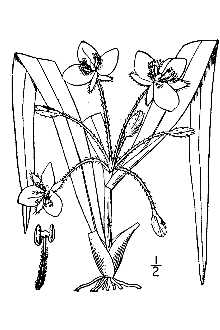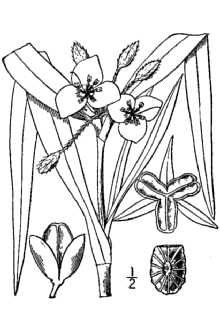Tradescantia brevicaulis Raf.
Scientific Name: Tradescantia brevicaulis Raf.

| General Information | |
|---|---|
| Usda Symbol | TRBR8 |
| Group | Monocot |
| Life Cycle | Perennial |
| Growth Habits | Forb/herb |
| Native Locations | TRBR8 |
Plant Guide
Alternate Names
Common spiderwort, dayflower, flower-of-a-day, Job’s tears, snake-grass, spider-lily, trinity, trinity-lily, widow’s-tears
Uses
Ethnobotanic: The Cherokee and other Native American tribes used Virginia spiderwort for various food and medicinal purposes. The young leaves were eaten as salad greens or were mixed with other greens and then either fried or boiled until tender. The plant was mashed and rubbed onto insect bites to relieve pain and itching. A paste, made from the mashed roots, was used as a poultice to treat cancer. A tea made from the plant was used as a laxative and to treat stomachaches associated with overeating. Virginia spiderwort was one of the seven ingredients in a tea used to treat “female ailments or rupture.” It was also combined with several other ingredients in a medicine for kidney trouble.
Status
Please consult the PLANTS Web site and your State Department of Natural Resources for this plant’s current status (e.g. threatened or endangered species, state noxious status, and wetland indicator values).
Description
General: Spiderwort Family (Commelinaceae). Virginia spiderwort is a native, perennial forb. This plant was probably named for the delicate spider web-like filaments that surround the anthers of the flower or the threadlike secretion that emerges from the stem upon cutting. The lightly fragrant flowers (2 to 5.4 cm in diameter) grow in terminal clusters. The flower’s three broadly ovate petals are generally bright blue but are sometimes purple, violet, rose, and rarely white. Individual blossoms last for only one or two days, but new blossoms appear daily throughout the spring blooming period. The plants grow in erect clumps that range from 30 to 60 cm in height. The rounded stalks are either single or branched at the base. The roots are thick and fleshy. The plant spreads through underground stems or stolons to form large colonies. The smooth iris-like leaves are long (15 to 46 cm) and narrow (2.5 cm wide) with a prominent midrib. © George F. Russell Smithsonian Institution, Dept of Botany @ PLANTS Distribution: For current distribution, please consult the Plant Profile page for this species on the PLANTS Web site. Habitat: Virginia spiderwort can be found in moist prairies, fertile woodlands, open woods, meadows, hillsides, stony bluffs, stream banks, and along roadsides.
Establishment
Virginia spiderwort is a vigorous plant that likes moist soils but will adapt to drier, average garden soils. The plants are often seen in old-fashioned gardens and work well as part of a perennial border. They are recommended for bogs and naturally wet sites where the plants can form large clumps when grown in full sun. The plants will flower in both sun and shade. Plants may be propagated from seed but they are more easily started from cuttings or divisions. For cuttings, take a single-node stem cutting late in the season, just as the plants begin to bolt. Place the cutting in moist soil up to the base of the leaf. To propagate by division, divide the thick roots in the fall or early in the spring. Be careful to divide the leaves so that each section includes its own roots. Established plants will self-sow and stalks that lay on the ground will readily root from the nodes.
Management
The foliage may be partially clipped back after blooming to control the size and untidy appearance of the plant. The plants will flower a second time in the late summer or fall if the stems are removed soon after the first flowering period. This vigorous grower can be somewhat controlled by dividing the plants every two to four years and by regularly removing the stalks that slump to the ground before they have the opportunity to take root. Large clumps may be divided by first lifting the root mass from the soil with a shovel. Then divide the clump into pieces that contain four to six shoots each with roots attached. Immediately plant and water the divisions.
Pests and Potential Problems
Virginia spiderwort is relatively pest and disease free, Snails will eat the young shoots, Cultivars, Improved and Selected Materials (and area of origin) These plant materials are somewhat available from commercial sources, Contact your local Natural Resources Conservation Service (formerly Soil Conservation Service) office for more information, Use soil moisture sensors to measure the soil moisture of Tradescantia brevicaulis Raf.., Look in the phone book under ”United States Government,” The Natural Resources
Conservation
Service will be listed under the subheading “Department of Agriculture.”
References
Bailey, L.H. & E.Z. Bailey 1976. Hortus Third: A concise dictionary of plants cultivated in the United States and Canada. Simon and Schuster Macmillan Co., New York, New York. 1290 pp. Banks, W.H. 1953. Ethnobotany of the Cherokee Indians. Master of Science Thesis, University of Tennessee, Tennessee. 216 pp. Chapman, A.W. 1883. Flora of the Southern United States: Flowering Plants and Ferns. Second Edition. J. Wilson and Son, Cambridge, Massachusetts. 698 pp. Coffey, T. 1993. The history & folklore of North American wildflowers. Houghton Mifflin, Boston, MA. 356 pp. Cullina, W. 2000. The New England Wild Flower Society guide to growing and propagating wildflowers in the United States and Canada. Houghton Mifflin Company, New York, New York. 322 pp. Hamel, P.B. & M.U. Chiltoskey 1975. Cherokee plants and their uses: A 400-year history. Herald Publishing Company, Sylva, North Carolina. 65 pp. Missouri Botanical Garden 2000. Tradenscantia virginiana. Kemper Center for Home Gardening. http://www.mobot.org/hort/plantfinder/Code/M/M63. htm. (18 June 2001). Moerman, D.E. 1998. Native American ethnobotany. Timber Press, Portland, Oregon. 927 pp. Moerman, D.E. 1999. Native American
Ethnobotany
Database: Foods, drugs, dyes and fibers of native North American Peoples. The University of Michigan-Dearborn. http://www.umd.umich.edu/cgi-bin/herb(18 June 2001) Phillips, H.R. 1985. Growing and propagating wild flowers. University of North Carolina Press, Chapel Hill, North Carolina. 331 pp. Small, J.K. 1933. Manual of Southeastern flora. University of North Carolina Press, Chapel Hill, North Carolina. 1554 pp. Smith, A.I. 1979. A guide to wildflowers of the Mid-south. Memphis State University Press, Memphis, Tennessee. 281 pp Taylor, K.S. and S.F. Hamblin 1963. Handbook of wild flower cultivation. The Macmillan Company, New York, New York. 307 pp. Tenenbaum, F. 1973. Gardening with wild flowers. Charles Scribner’s Sons, New York, New York. 206 pp.
Plant Traits
Growth Requirements
| Temperature, Minimum (°F) | -38 |
|---|---|
| Adapted to Coarse Textured Soils | No |
| Adapted to Fine Textured Soils | Yes |
| Adapted to Medium Textured Soils | Yes |
| Anaerobic Tolerance | None |
| CaCO3 Tolerance | Low |
| Cold Stratification Required | No |
| Drought Tolerance | Medium |
| Fertility Requirement | Low |
| Fire Tolerance | None |
| Frost Free Days, Minimum | 100 |
| Hedge Tolerance | None |
| Moisture Use | Medium |
| pH, Maximum | 8.0 |
| pH, Minimum | 4.0 |
| Planting Density per Acre, Maxim | 19360 |
| Planting Density per Acre, Minim | 10912 |
| Precipitation, Maximum | 55 |
| Precipitation, Minimum | 25 |
| Root Depth, Minimum (inches) | 4 |
| Salinity Tolerance | None |
| Shade Tolerance | Intermediate |
Morphology/Physiology
| After Harvest Regrowth Rate | Slow |
|---|---|
| Toxicity | None |
| Resprout Ability | No |
| Shape and Orientation | Erect |
| Active Growth Period | Spring |
| Bloat | None |
| Coppice Potential | No |
| Fall Conspicuous | No |
| Fire Resistant | No |
| Flower Color | Blue |
| Flower Conspicuous | Yes |
| Foliage Color | Green |
| Foliage Porosity Summer | Porous |
| Foliage Porosity Winter | Porous |
| Fruit/Seed Color | Black |
| Nitrogen Fixation | None |
| Low Growing Grass | No |
| Lifespan | Short |
| Leaf Retention | No |
| Known Allelopath | No |
| Height, Mature (feet) | 1.1 |
| Growth Rate | Rapid |
| Growth Form | Single Stem |
| Fruit/Seed Conspicuous | No |
| Foliage Texture | Medium |
Reproduction
| Vegetative Spread Rate | None |
|---|---|
| Small Grain | No |
| Seedling Vigor | High |
| Seed Spread Rate | Moderate |
| Fruit/Seed Period End | Summer |
| Seed per Pound | 1750000 |
| Propagated by Tubers | No |
| Propagated by Sprigs | No |
| Propagated by Sod | No |
| Propagated by Seed | Yes |
| Propagated by Corm | No |
| Propagated by Container | No |
| Propagated by Bulb | No |
| Propagated by Bare Root | Yes |
| Fruit/Seed Persistence | No |
| Fruit/Seed Period Begin | Spring |
| Fruit/Seed Abundance | Low |
| Commercial Availability | No Known Source |
| Bloom Period | Spring |
| Propagated by Cuttings | No |
Suitability/Use
| Veneer Product | No |
|---|---|
| Pulpwood Product | No |
| Post Product | No |
| Palatable Human | No |
| Palatable Graze Animal | Low |
| Palatable Browse Animal | Low |
| Nursery Stock Product | No |
| Naval Store Product | No |
| Lumber Product | No |
| Fodder Product | No |
| Christmas Tree Product | No |
| Berry/Nut/Seed Product | No |





